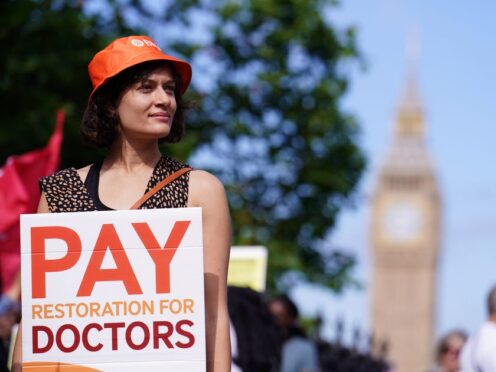
Health leaders have warned that strikes “must not become the status quo” for the NHS as junior doctors in England return to work after a “challenging” five-day walkout.
Experts said patients are “bearing the brunt” of the dispute, with delays caused by the postponement of appointments leaving them in “pain or discomfort”.
It is expected that tens of thousands of appointments, procedures and operations were postponed as a result of the industrial action by members of the British Medical Association (BMA).
NHS leaders said hospitals have been left to “pick up the pieces” as staff work to reschedule all of the appointments lost during strike days.
Officials are expected to confirm the number of appointments that were postponed on Friday – the day after voters take to the polls in the General Election.
Both the Conservatives and Labour have pledged to resume talks with the BMA’s Junior Doctors Committee if they are voted to power.
Health Secretary Victoria Atkins pledged to “get back into the negotiating room immediately after the election” while Labour’s shadow health secretary Wes Streeting said that he will call the BMA on July 5.
Health leaders have called for the long-running dispute to be brought to a close swiftly.
Matthew Taylor, chief executive of the NHS Confederation, said the impact of the strike will be felt “for some time to come” adding: “We know that tens of thousands of operations and appointments are likely to have been cancelled.
“Now health leaders and their teams will need to begin picking up the pieces by rescheduling all these so that patients can get the treatments they so desperately need.

“It is important to remember that it is patients who are bearing the brunt of this ongoing dispute, patients who are often waiting in pain or discomfort for care.
“While we recognise that junior doctors have genuine issues over pay, conditions and training, it is questionable that these strikes in the midst of a General Election campaign could have moved the dial. We are concerned that so many patients should have their care disrupted when no government was in a position to negotiate.
“We hope that the next government can re-start negotiations and bring this dispute to an end so the NHS can focus on improving performance and cutting waiting lists rather than filling rota gaps and rescheduling appointments.”
Saffron Cordery, deputy chief executive of NHS Providers, said: “This strike may have ended but more could be on the horizon unless the next government resolves the NHS industrial disputes as a matter of urgency.
“Damaging and demoralising strikes must not become the status quo for the NHS and patients.
“There have been no winners in this strike. Tens of thousands of patients have had their care disrupted, junior doctors are still in dispute and trusts will have incurred huge costs paying senior staff premium rates to cover striking staff at a time they can least afford it.
“With the country going to the polls this week, trust leaders will be looking to the next government and junior doctors to reset industrial relationships and prevent further walkouts. The alternative doesn’t bear thinking about.”
From 7am we strike until 7am on 2 July.
This is a critical stage of our #PayRestoration campaign which comes at a time when the general election swirls around our dispute.
Let's make this #DoctorsStrike the biggest and loudest yet. Tag us in your posts so we can share them 📸 pic.twitter.com/3ct1pd5Cch
— Junior Doctors (@BMA_JuniorDocs) June 27, 2024
Professor Sir Stephen Powis, NHS England’s national medical director, said: “This round of industrial action has now ended and staff will work quickly to rebook appointments that have been impacted.
“I would like to thank NHS staff for their incredible efforts during the last five days, and patients who have continued to use services as normal during an extremely challenging time.
“As ever, 999 and A&E are there for life-threatening emergencies, while 111 on the NHS app, online, or by phone can be used for other health concerns.”
Professor Philip Banfield, chair of council at the BMA, said: “This week the Prime Minister sadly declined to make a commitment to fair pay. This Government has failed junior doctors once again, as they have done across a decade of mismanagement of the health service.
“A refusal to simply listen to frontline staff and deal with chronic workforce shortages has led to waiting lists at scandalous lengths and an NHS at the point of collapse.
“After 11 rounds of strike action in the face of ever-declining value of their pay, doctors have now emphatically shown they will not take it lying down.
“It will be for the government elected this week to take a new direction – one of collaboration not conflict with NHS staff, one where the health service gets the investment it needs, and where healthcare in this country gets an injection of the medicine it has sorely been lacking – hope.”
The walkout was the 11th strike by junior doctors in 20 months.
Junior doctors make up half of the medical workforce and their last walkout in February led to 91,048 appointments, procedures and operations being cancelled.
Medics in training have said their pay has been cut by more than a quarter over the last 15 years and have called for a 35% increase.

Enjoy the convenience of having The Sunday Post delivered as a digital ePaper straight to your smartphone, tablet or computer.
Subscribe for only £5.49 a month and enjoy all the benefits of the printed paper as a digital replica.
Subscribe